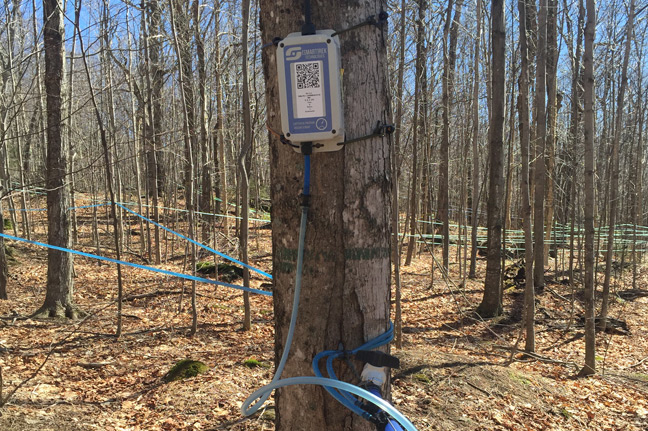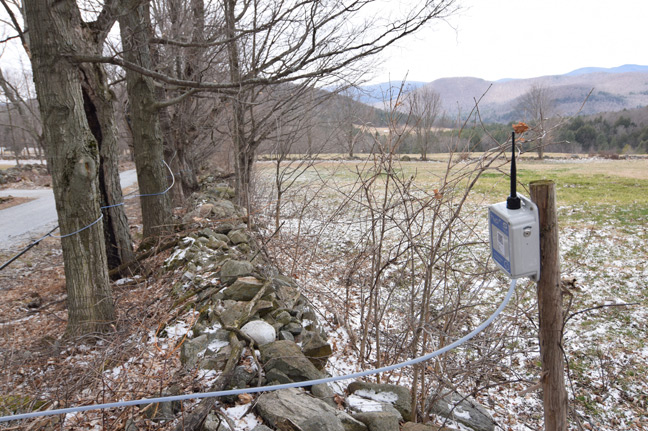UVM Proctor Page
Using Smartrek vacuum monitoring system
In 2016, PMRC completed the build-out of its system to provide coverage for all its sugarbush
By BY TIMOTHY D. PERKINS AND MARK L. ISSELHARDT |
Four main factors influence sap yields from maple trees. First there is the tree resource itself. Healthy trees with adequate functional sapwood, crown exposure to the sun on fertile soils with adequate moisture have good growth rates and produce well. Secondly, weather conditions suitable for stimulating sap flow (freeze-thaw events) must occur to start the process. Thirdly, excellent spout and tubing sanitation practices will result in slower microbial contamination of tapholes and slow the resulting tree compartmentalization during the season, producing stronger sap flows that last later in the spring. Finally, higher vacuum levels create a greater pressure gradient from the inside of the tree to the outside, producing higher flows from tapholes. Good attention to all these details will produce the best outcome in terms of better production. Changes to industry practices have resulted in rapidly increasing sap yields for producers utilizing these approaches.
Improved pumps, design and layout of maple tubing systems, as well improved tubing, fittings and spouts have led to higher and higher vacuum levels. However maintaining such a high level of vacuum requires constant attention to monitor vacuum levels across a widely distributed network of tubing, and when a leak is detected, prompt action to locate and fix leaks. These activities, although necessary, require considerable time and effort.
At the University of Vermont Proctor Maple Research Center (PMRC), we have explored several different methods of both custom-built and commercially available vacuum monitoring over the past fifteen years. In general however, it was not until quite recently that technological advances in sensors and wireless communications saw the commercial availability of robust and cost-effective remote vacuum monitoring systems suitable for maple industry applications.
During the winter of 2013-2014, PMRC acquired the Smartrek Technologies monitoring system as both a way to monitor sap flow variables during the season for research and for our production sugarbush of 4,200 taps. Initially our coverage was about 1/3 of our operation. In 2015 we expanded the system to have coverage of about ½ the sugarbush. In 2016 we completed the build-out of the system to provide coverage for all our sugarbush. Our present system includes over 72 vacuum/temperature sensors distributed across the two major sections of our sugarbush, as well as 8 tank level sensors, and 10 pressure sensors. In each case, it was a very simple matter to expand our system by the addition of new nodes.
Although this article discusses our experience with the Smartrek system (now distributed by H2O, Inc.), there are several other types of wireless vacuum monitoring systems available. We have not reviewed all of these, but encourage producers to explore their options. We selected the Smartrek system because it was one of the earliest wireless mesh-network systems developed, had a wide range of features available, and the company was very easy to communicate with and was open to suggestions for changes and the development of custom sensors for our research work. We have been extremely pleased with our choice.
The Smartrek system as currently configured includes a stationary “Gateway”, which connects the various nodes (sensors) together and connects them to the internet. The “Gateway” is typically located at a central position where serves as the base-station for communications. A “Portable Gateway” is also available for use in the field when installing “Nodes”, trouble-shooting sensors, or fixing leaks. While some users may wish to use a “Portable Gateway” in such fashion, in practice at PMRC, we rarely use it. This may be because our density of nodes is high, so signal strength is typically not an issue. For users who wish to have a system with widely spaced nodes or who wish to use it for locating leaks, the “Portable Gateway” may have far more utility. The next element of the system is an Android-based Tablet or Smartphone running the Smartrek “Sugarheld” software (no iOS version is currently available). The tablet and software are primarily used to add, edit, or calibrate“Nodes” (sensors) and to display the data coming from the “Nodes” in the woods. “Nodes” are the individual sensors that measure the variable you are interested in, and communicate the information to the rest of the network. Together, a series of “Nodes” create a mesh-network of sensors which communicate with each other in a sort of leap-frog manner, and eventually pass all information to the “Gateway” and “Tablet” for display and to the internet for data storage. Data can also be viewed on an internet browser, although with fewer features and programming of the system not supported in this way. The particular software that UVM PMRC has used is a custom-version that supports addition sensor types, therefore our experience with the software may vary slightly from that of other users.
A variety of “Nodes” are available – the most common is the vacuum node. This type of node comes in two flavors, single vacuum or double-vacuum. In the PMRC operation, most vacuum “Nodes” are the single type, although we do employ a few double-vacuum sensors where we have two pumps located in the same place. Using double-nodes will reduce the cost somewhat, but are slightly less convenient for monitoring vacuum in mainlines, since 5/16” tubing would have to be run between adjacent mainlines. For simplicity sake, we employ single-vacuum sensors at the end (or sometimes in the middle) of each mainline. In addition to vacuum, these nodes also measure temperature, although because the sensor is inside the unit, the temperature reflects that of the box itself, not air temperature.
Besides vacuum nodes, tank-level sensors are available. One advantage of the Smartrek sensor is that it is wireless/ultrasonic and placed above the sap (or other) tank, so there are no probes in the sap to get in the way or clean. These sensors are very easy to install and calibrate, and are actually quite sensitive, so measuring sap tank depth is both simple and accurate. Another “Node” is a relay, which will allow remotely switching on or off of various types of equipment.
Because of our work as a research station, we also needed a Pressure sensor. Upon our request, Smartrek Technologies built several custom pressure sensors for us. These sensors allow us to monitor the amount of pressure in untapped trees during the freeze/thaw cycle, and is used in both our maple and birch research. Other types of sensors are also being considered.
Our experience with the Smartrek system has been very positive. In use, we will check the system in the morning to determine which, if any, of the mainlines are showing low vacuum and note those areas needing work. This allows us to prioritize the areas needing attention, and to skip those areas where the vacuum remains high. The main benefit of the system is to pinpoint the areas where time must be spent to restore vacuum levels quickly, therefore allowing a better deployment of personnel to trouble-spots, and a quick resolution of leaks. This allows us to be far more efficient in the use of personnel, and thus spend more time on other things. Since none of the staff live at PMRC (it just seems that way sometimes), the system also allows us to be confident when we are not on-site that vacuum levels are good and that tanks are not overflowing. In short, the Smartrek system allows us to keep an eye on things without actually having to be here all the time. Another use is to locate which mainlines are prone to freezing. For those lines where good vacuum is not maintained during a freeze, a low spot or small leak which causes icing is usually to blame. Consistent loss of vacuum during freeze periods allows us to identify these trouble areas for remedial action during slow times or during the off-season.
An example of how the system helps is illustrated by the following. Our birch research continues for several weeks after the maple season is over. The birch trees at PMRC are widely spaced and so are connected to several various parts of our tubing system for our maple operation for vacuum. One morning in 2015 the vacuum level was considerably lower than normal. Instead of having to start walking through the woods trying to track down a big leak from 4,200 taps, a quick look at the Smartrek data pinpointed the leak to a single mainline, and 15 minutes later the problem was fixed and the vacuum restored. What would have taken hours to half a day a few years ago was resolved in 15 minutes using the Smartrek system. Since sap flow is directly proportional to vacuum (5-7% increase for each inch Hg), the ability to find leaks quickly during the actual sugaring season helps both prevent the loss of valuable sap while at the same time saving producer time and effort spent looking for leaks manually. Since a few major leaks during peak sap flows or tanks running over can make the difference between a profitable and a poor season, having an electronic monitoring system working for you can be both a money saver and provide a sense of security that everything is going well.
A few shortcomings have been identified after using the system for a few years. The first is in the area of how best to site the sensors. Since the system works by connecting a network of nodes (sensors) each node must have a ‘path’ back to the gateway in order to be visible. Given that the terrain in most sugarbushes is varied, there will inevitably be areas where communication back to the gateway is spotty or impossible. Sensors alone do not simply clearly let the user know in the field the strength of the signal. We have been able to overcome this through trial and error, and by adding in “repeaters” in troublesome areas. It is also important that when starting up the system for the season, that the sensors closest to the gateway be turned on first and that you progress outward to the most distant sensors. This ensures that communication with nodes is well established. A second issue is battery life. Rapid refresh rates can deplete batteries in less than a full season, however in most cases such short-term updating is not necessary, and battery life will be longer. To counter any possibility of a problem, we replace all batteries (3 D-cells) annually during the off-season, and leave the sensors in the woods with the power off until tapping. This represents an added expense in supplies, time, and labor.
As the sophistication of these types of technological monitoring systems grows and the field matures, possible features we would like to see implemented include: automatic GPS location of devices, improved siting tools for installing the nodes, a visual display of vacuum, temperature, and battery level on the sensor itself, logic-based alarming (example: do not send a text/email alert for vacuum sensors if temperatures are below 30°F), and improved data handling and analysis capabilities.
As maple operations grow in size, expense and complexity, the need for labor-saving strategies to maintain high yields also increases. Vacuum monitoring systems can improve the ability of producers to manage their vacuum tubing systems provided they are installed correctly, maintained properly, and used to efficiently focus attention on areas that need it the most.
** Any reference to commercial products, trade names, or brand names is for information only, and no endorsement or approval is intended.
Timothy D. Perkins is Research Professor & Director, University of Vermont Proctor Maple Research Center, Underhill Ctr. Mark L. Isselhardt is Extension Maple Specialist, University of Vermont Proctor Maple Research Center, Underhill Ctr.
April 2016

































